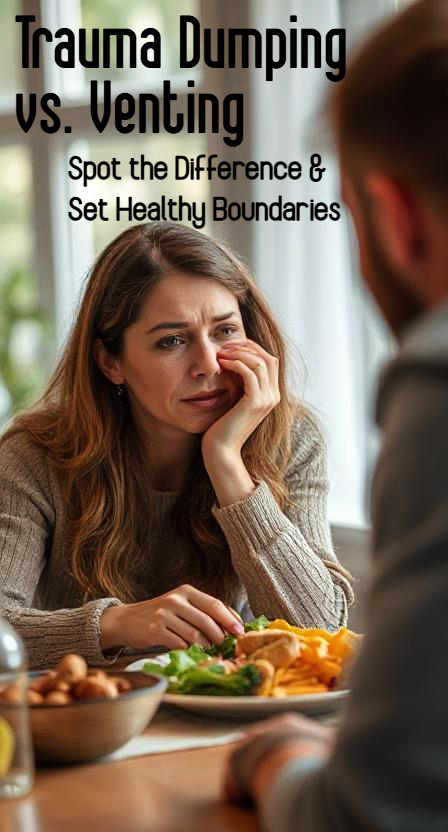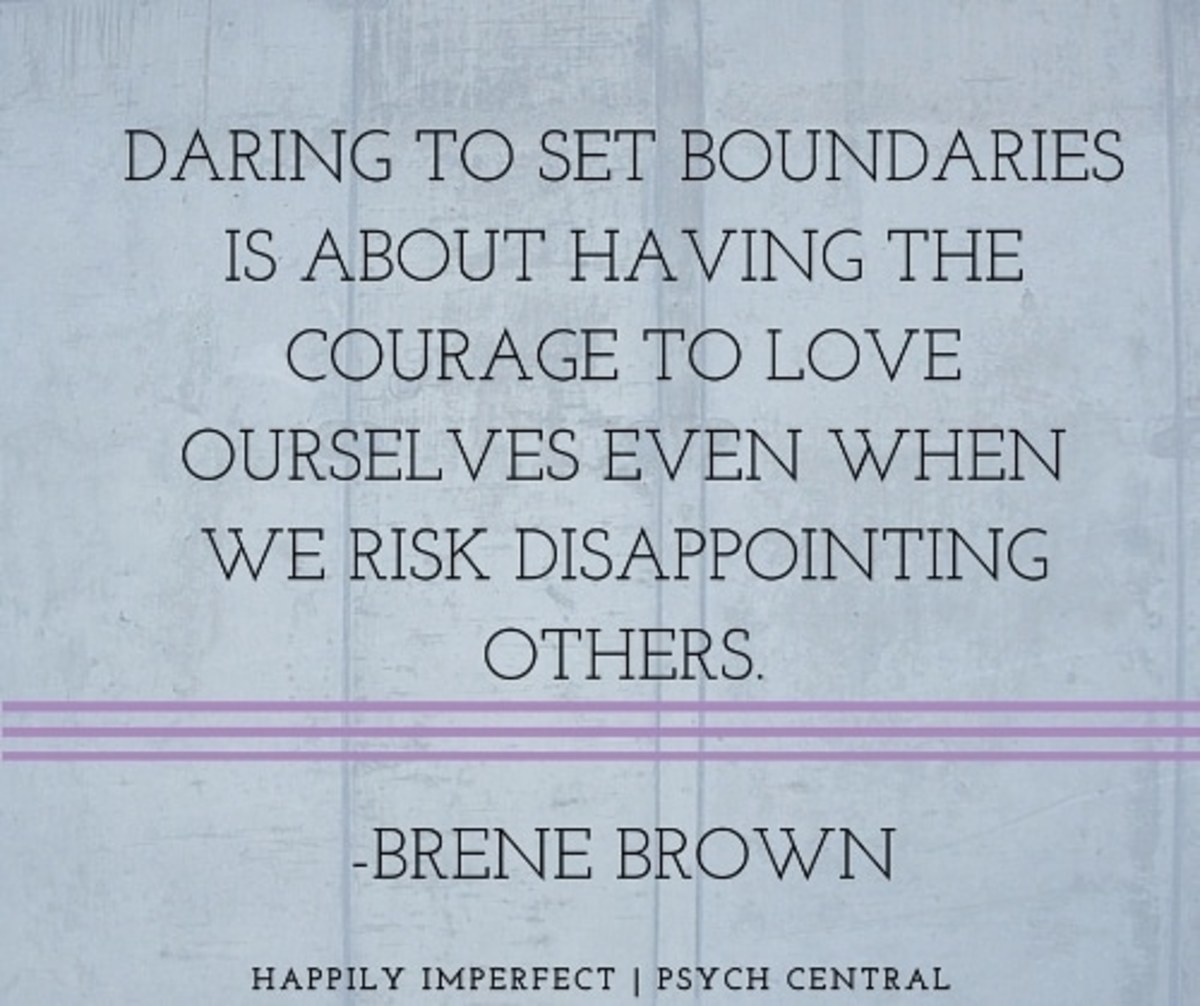Trauma Dumping vs. Venting: How to Spot the Difference and Set Healthy Boundaries

Trauma Dumping vs. Venting: How to Tell When Emotional Sharing Crosses the Line
Imagine this: You're standing there, minding your own business, when someone runs up to you, shoves a suitcase—heavy as bricks—into your arms and says, “Here. Take care of this.” That’s what trauma dumping feels like.
Some conversations stay with you—not because they were necessarily meaningful, but because they caught you off guard. You walk away emotionally disoriented, unsure what just happened, because someone offloaded their emotional baggage without warning. Maybe you were trying to be supportive, but it felt more like being emotionally ambushed.
Other times, even a heavy conversation can leave you feeling closer and more connected. In the suitcase example, the person might have asked, “Can you help me carry this?” That’s the difference: impact, context, and consent. It’s what separates trauma dumping from healthy venting.
Recognizing that distinction can protect your mental health, preserve your relationships, and help you offer support to people in your life without becoming emotionally depleted.

What Is Trauma Dumping? When Emotional Oversharing Crosses a Boundary
You’re catching up with a coworker over lunch—nothing deep, just a typical midweek chat about deadlines, weekend plans, and how challenging it feels to juggle work and life lately. You make a light comment about needing a vacation. Then, without warning, your colleague divulges, “I had a miscarriage last year. I still cry about it almost every day. I just can’t seem to move on.”
You weren’t expecting the conversation to take that sudden turn. There was no lead up, no context, no check-in to see whether you were in the right headspace for something so personal. And while miscarriage is a painful, deeply human experience that deserves patience and care, it can feel disorienting when dropped into a lunchtime work conversation without warning—especially when you have a meeting in 10 minutes.
This is where trauma dumping differs from healthy emotional expression. It’s not about the content being inappropriate—it’s about the delivery, the lack of emotional boundaries, and the absence of two-way understanding.
Trauma dumping is when someone unloads intense personal experiences—often without warning, context, or consent—regardless of the other person’s capacity to process or respond.

Emotional Oversharing: The Hidden Cost of Trauma Dumping
Trauma dumping is the act of unloading deeply personal, often disturbing emotional content onto someone else—without their consent, without context, and without ensuring the listener is emotionally prepared to receive the information. It disregards whether the other person is equipped to absorb what’s being shared. It also doesn’t allow for reciprocity or dialogue. Instead, it floods the listener with raw, unresolved pain in a way that can leave them feeling helpless, burdened, or even traumatized themselves.
That doesn’t mean the pain isn’t real or valid. The issue isn’t what is being shared—it’s how and when.
Trauma dumping happens when someone disregards emotional cues, the setting, and your consent, and unloads their pain for their own relief, not to seek mutual support. That’s the line between healthy vulnerability and emotional dumping. The problem isn’t the depth of emotion; it’s the lack of consideration.
It’s one thing to say, “I’ve been dealing with something difficult lately—can I talk to you about it?” It’s another to spring intensely personal revelations into casual conversation, ignoring whether the listener is emotionally ready or able to help. This kind of one-sided emotional unloading can lead to secondary trauma, especially when what’s being shared involves abuse, violence, or other deeply distressing experiences.1

What Is Venting? Understanding Healthy Emotional Release
Venting, by contrast, is typically mutual, paced, and aware of the context. It’s the emotional steam-release valve.
You’ve had a terrible day, your manager moved the deadline for an important presentation yet again, and you need to talk to someone who “gets it.” You call a friend and say, “Do you have a minute? I need to rant.” You’re frustrated but not overtaking the conversation. You’re open to a response, not just releasing without pause. You’re reaching out to connect, not just discharging emotion.
Venting is emotional expression with boundaries. It doesn’t cross into "overwhelm territory" or create a power imbalance. Perhaps most importantly, venting often invites support or feedback, rather than demanding emotional absorption.
Venting is sharing frustrations in a way that invites connection and support—expressing emotions without overwhelming the listener.

Why People Trauma Dump and How It Affects Listeners
People who trauma dump aren’t necessarily selfish, and they certainly don't intend to create harm. Oftentimes, they simply don’t have other outlets for their pain. They may lack emotional coping skills, or perhaps they have spent years in environments where no one listened unless they were in crisis. That doesn’t mean the behavior is healthy or fair, however.
When someone trauma dumps without consent from the listener, it can create real psychological consequences for the person on the receiving end. If you’re not a trained therapist or don’t have experience navigating topics like assault or child abuse, you may feel panicked, unsure how to respond, or even physically ill. In some cases, trauma dumping can retraumatize people who’ve experienced similar pain, triggering flashbacks or emotional shutdowns.2
For people who care deeply, having someone's trauma unloaded on you suddenly can feel like a moral dilemma. You want to help, but you’re not a crisis hotline. You may not have the training, context, or resources to carry what’s being dropped into your lap.
How do you feel when someone unloads heavy stuff on you without warning?

Consent, Timing, and Readiness
The difference often comes down to consent. Venting typically begins with a cue: “Hey, can I share something frustrating?” or “I need to talk—are you okay hearing about something kind of heavy?” Trauma dumping skips the check-in. It barrels forward without considering whether the listener is emotionally prepared or ready to hear the story.
There’s also the question of timing and relationship depth. Oversharing is more likely to feel like trauma dumping when it occurs early in a relationship or in inappropriate settings—like unloading childhood abuse stories during a first date or recounting vivid medical trauma while your friend is picking their kid up from school. It’s not that these experiences are shameful or should be hidden. It’s that a healthy connection honors the boundaries, capacity, and role of the listener.

When Urgency Is Appropriate
Some situations call for sharing deeply painful experiences—urgently and without hesitation. If someone is expressing thoughts of suicide or self-harm, fleeing abuse, or facing a serious health emergency, their safety takes precedence over the timing or context of conversations. That’s not trauma dumping. That’s reaching out in crisis.
What to Do If Someone Trauma Dumps on You
If you find yourself on the receiving end of trauma dumping, it’s okay to set limits. You can be compassionate without becoming a container for pain you’re not equipped to hold. Consider saying:
- “That sounds incredibly painful, and I want to support you, but I don’t think I’m the right person to help you with this.”
- “I care about you, but I’m not sure I have the skills to help you with this. Have you talked to a counselor or therapist?”
- “This sounds so important, and I want to give it the attention it deserves. Could we find a better time or someone who’s better equipped to help?”
- “That’s a lot to take in so quickly. I care, but I need a little time to process.”
- “I want to listen, but I’m feeling overwhelmed by all that you've just disclosed. Can we pause and come back to this when I’m more grounded?”
- “Can we pause here for a moment? I want to be respectful of what you’re sharing, but I’m feeling a bit overwhelmed.”
If someone continues to bypass your boundaries or share graphic details without checking in, it’s okay to distance yourself or be more direct. Being someone’s emotional dumping ground isn’t the same as being a good friend. Protect your own emotional boundaries.

If You’re Unsure Whether You’re Trauma Dumping
If you're uncertain about whether the information you're sharing counts as trauma dumping, take a moment to reflect.
Ask yourself:
-
Did I check whether the other person was open to this conversation?
-
Am I giving them room to speak, or am I releasing everything at once?
-
Have I shared this story multiple times in this same way, to multiple people?
-
Am I seeking connection, or just release?
-
Is this person trained or aware of resources to help me with what I’m sharing?
There's certainly no shame in needing help if you’re struggling with painful memories or emotions that feel too big to hold. However, it’s important to choose the right time, person, and method for sharing. While friends can offer compassion, they often do not have the capacity or professional tools to help you heal.
Venting is a healthy, often reciprocal form of emotional expression. Trauma dumping, on the other hand, can feel like an emotional sneak attack. It often comes without warning, overwhelms the listener, and bypasses mutual consent.
That doesn’t mean people who trauma dump are bad. Instead, it means they need better strategies for processing their pain as well as a clearer understanding of when and how to share it. If you’re often on the receiving end of trauma dumping, you’re allowed to protect your own mental health.
Real connection—the kind that heals—requires respect, readiness, and emotional boundaries.

References
1 Marshall, E. K. (2022, September 14). What is trauma dumping and how to handle it. PsychCentral. https://psychcentral.com/health/what-is-trauma-dumping
2 Raypole, C. (2022, June 30). What is secondary trauma? Healthline. https://www.healthline.com/health/secondary-trauma
© 2025 Elaina Baker








